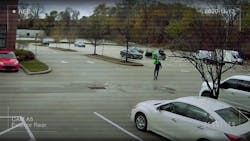Tech Trends: Weapons Detection's Role in Shooter Prevention
This article originally appeared in the August 2022 issue of Security Business magazine. When sharing, don’t forget to mention Security Business magazine on LinkedIn and @SecBusinessMag on Twitter.
In an instant, the lives of so many were changed. Gunshots were fired, killing innocent children. The days and weeks to follow filled with blame, political pontification, and anger – at the shooter, the current system, and an unclear solution to prevent the next tragedy.
The weight of recent events cast a shadow on my interview with Rob Huberty, Co-Founder and COO of ZeroEyes, an AI weapons detection platform that identifies visible guns at first sight.
The discussion was supposed to be light-hearted; to discuss the company’s recent award for being the first video analytic to receive DHS SAFETY Act certification. I wanted to gain a deeper understanding of the ZeroEyes technology, which is already being used by Oxford High School in Michigan – site of a yet another recent and tragic school shooting – to reduce the likelihood of mass shootings on campus.
Instead, the conversation turned from short-lived success stories to potentially mitigating mass shooting incidents.
The Search for Time
ZeroEyes is one of many weapons detection technologies on the market. Most weapons detection technologies are focused on weapons of mass destruction, such as guns and explosives, though some can detect bladed instruments as well. Let’s be clear: A passive weapons detection technology will never, by itself, stop a person or a weapon.
In an active shooter scenario, the incident is usually over in less than two minutes. The average police response time can be anywhere from 4 to 11 minutes for high-priority calls. This gap in response time must be closed. The purpose of weapons detection technology is to provide time. While it seems less of an active solution, time is precious in an active shooter scenario. Each second is a lifetime; each second provides another chance at survivability.
In those seconds, the weapon detection analytic can initiate a lockdown of a building, preventing or delaying access to the building. In those seconds, onsite security, public safety, or others with extreme valor can begin a tactical response.
Technology cannot disarm a suspect or stop a shooting. At this point, only a human can stop another human. Weapon detection technologies proactively help create those precious seconds of time.
Technology with a Human Element
According to Huberty, “ZeroEyes provides a security solution, not just a video analytic.”
The ZeroEyes solution uses IP cameras to monitor for visible, brandished guns – with the claim that if a human could identify it, so canthe analytic. The system supports the analytic by having a human in the loop verify the alert.
AI will never be 100% accurate, and ZeroEyes technology is no different. Knowing what to look for and how to react in an active shooter scenario requires comprehensive training, the kind only found in real-world scenarios. ZeroEyes hires combat veterans and prior law enforcement officers to verify alerts as part of its monitoring solution.
The ZeroEyes analytic uses existing IP cameras of at least 1.3MP (720p) resolution or higher. The better the resolution, the better the detection. The AI is not perfect though, and other security professionals will point to the ZeroEyes analytic being unable to discern a gun from a cell phone, if the cell phone is held like a gun. Is it a gun, or is a cell phone? This has to be treated as an actual gun, and must be dispatched on with the same severity as a real gun.
A 2020 article on real-time gun detection in the Journal of International Neural Network Society supports this problem, reporting that small weapons are 38% less likely to be accurately detected than larger weapons.
Systems like ZeroEyes rely on monitoring center operators to verify a detection and dispatch via a mobile application and to initiate a call to local law enforcement. Human-verified systems offer higher accuracy that can drive swifter response.
Other weapons detection systems rely on physical presence of staff or a lower accuracy with an immediate activation of lockdowns or alarms.
All options must be weighed when selecting a solution. The one truth is that without a weapons detection system in place, it is very unlikely weapons will be detected before they enter a building.
Today, ZeroEyes is deployed in schools, Fortune 100 companies and retail establishments in 17 states. Weapons detection technologies are also used at most major sporting venues, theme parks and large retail malls.
“The majority of our founders are fathers, and we were compelled to create this solution after seeing tragic school shootings like Sandy Hook, Parkland, and now Robb Elementary,” Huberty says. “We are trying to address the issue in the best way we can, and that’s by creating a solution to proactively mitigate mass shooting incidents. We have detected more than 1,000 fake and real guns being brought into schools and other locations, and consider every life saved to be a victory."
According to ZeroEyes, the solution currently detects multiple guns every day that are not false positives. Deployed in just 90 schools, there is still not a day that goes by that they do not detect at least one gun. Some of the detected guns are Airsoft and water guns, butthey are dispatched on each time since they are verified by sight as a gun. Why? One reason is that real guns are sometimes painted like Airsoft guns to make it past unsuspecting security.
Huberty explains a significant rise in guns being brought to schools, through a common practice called Senior Assassin, a competitive game in which seniors are assigned targets and have to “shoot” their target with a water gun or Airsoft gun while at school. With a constant influx of fake guns in scenarios like these, this creates an atmosphere of human complacency – a fault that AI cannot succumb to.
Complacency contributes to flawed situational awareness, where either apathy or shock prevents the logical responses to an active shooter – a story the media has sunk its teeth into in Uvalde. Complacency can be found not only in the human response, but the maintenance of the camera.
AI-enabled analytics require the camera be well-maintained in proper working order. The reality is that AI analytics are never complacent. They are only as good as the functionality of the sensor, and the AI model in how they were trained.
While many analytics companies offer a suite of analytics, AI-enabled analytics tend to be the most accurate when they are trained to look for a specific thing, which in the case of ZeroEyes, is a library of weapons.
Be a Good Partner
As trusted security advisors, integrators are close with many of their end-users, and many times they specifically request solutions such as weapons detection systems. While most weapons detection systems are not line-card items – rather, they are a unique one-off system – but hopefully that will change.
Like many other weapons detection systems manufacturers, ZeroEyes has completed some of its own installations. The need for more integration channel partners is there to provide weapons detection solutions as end-user demand drives more applications.
As a technology trend, the gap in response times to mass shootings cannot be afforded its current measure. ZeroEyes is taking a leading step, and they are not alone; however, I challenge other weapons detection manufacturers to step up, and integrators to partner with them to help in widespread deployment.






